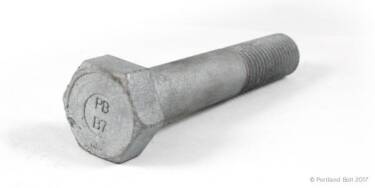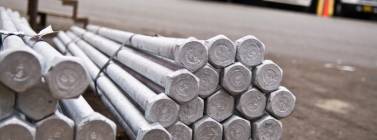According to the information you give in your site, ASTM A193 Grade B7 can be galvanized. However, this material does not have a maximum tensile strength. Thus, it is possible to have ASTM A193 Grade B7 bolts with a tensile strength higher than 150 ksi and in this case, bolts should not be galvanized. What is your experience about this matter and how high can the tensile strength be in a current production?
 The concern with galvanizing any high strength steel is the risk of hydrogen embrittlement. There is plenty of research on galvanizing high strength steels, but conclusions vary on the strength at which hydrogen embrittlement will likely occur when the parts are galvanized. Some research identifies 150 ksi tensile strength as a threshold, but other research indicates that the strength threshold is slightly higher. The documentation that the Bolt Council (Research Council for Structural Connections) cites provides a strength threshold of 39 HRC which equates roughly to 177 ksi.
The concern with galvanizing any high strength steel is the risk of hydrogen embrittlement. There is plenty of research on galvanizing high strength steels, but conclusions vary on the strength at which hydrogen embrittlement will likely occur when the parts are galvanized. Some research identifies 150 ksi tensile strength as a threshold, but other research indicates that the strength threshold is slightly higher. The documentation that the Bolt Council (Research Council for Structural Connections) cites provides a strength threshold of 39 HRC which equates roughly to 177 ksi.
“The susceptibility of steel fasteners increases significantly when the specified hardness is above 39 HRC (380 HV). Steel fasteners with a specified hardness below 39 HRC (380 HV), normally have no significant susceptibility to hydrogen embrittlement failure.”
- HYDROGEN EMBRITTLEMENT IN STEEL FASTENERS SALIM BRAHIMI ENG. July, 2014 IBECA Technologies Corp. (Section 5.1)
Now let’s look at the mechanical requirements of A193 Grade B7, and for comparison purposes, I have included A354 Grade BC.
| Grade Marking | Specification | Material and Treatment | Nominal Size (In.) | Mechanical Properties | Hardness Rockwell | |||||
|---|---|---|---|---|---|---|---|---|---|---|
| Proof Load Min (ksi) | Yield Strength Min (ksi) | Tensile Strength Min (ksi) | Elong % Min [9] | RA % Min [10] | Min | Max | ||||
 |
A193 Grade B7 | Medium Carbon Alloy Steel, Q & T | 1⁄4" - 21⁄2" | - | 105 | 125 | 16 | 50 | - | C35 |
| 25⁄8" - 4" | 95 | 115 | 16 | 50 | C35 | |||||
| 41⁄8" - 7" | 75 | 100 | 18 | 50 | C35 | |||||
 |
A354 Grade BC | 1⁄4" - 21⁄2" | 105 | 109 | 125 | 16 | 50 | C26 | C36 | |
| 25⁄8" - 4" | 95 | 99 | 115 | 16 | 45 | C22 | C33 | |||
A193 Grade B7, depending on diameter, has a minimum tensile strength ranging from 100 ksi to 125 ksi. As you stated, there is no maximum strength requirement. So, theoretically, you could have an individual lot of bolts that could exceed 150 ksi or even 177 ksi and therefore raise concern about galvanizing these parts due to hydrogen embrittlement risks. However, there is a maximum hardness requirement ranging from HRC 33 – HRC 36 depending on diameter. Although there is no maximum tensile requirement, the maximum hardness requirement limits the tensile strengths, depending on diameter, to roughly 152 ksi, 160 ksi, or 165 ksi.
| Rockwell | Rockwell Superficial | Brinell | Vickers | Shore | Approx Tensile Strength (psi) | |||||||||
|---|---|---|---|---|---|---|---|---|---|---|---|---|---|---|
| A | B | C | D | E | F | 15-N | 30-N | 45-N | 30-T | 3000 kg | 500 kg | 136 | Sciero-scope | |
| 60kg Brake | 100kg 1/16" Ball | 150kg Brake | 100kg Brake | 100kg 1/8" Ball | 60kg 1/16" Ball | 15kg Brake | 30kg Brake | 45kg Brake | 30kg 1/16" Ball | 10mm Ball Steel | Diamond Pyramid | |||
| 68.4 | 109 | 36 | 52.3 | - | - | 78.3 | 55.9 | 38.4 | - | 336 | - | 354 | 49 | 165,000 |
| 67.9 | 109 | 35 | 51.5 | - | - | 77.7 | 55.0 | 37.2 | - | 327 | - | 345 | 48 | 160,000 |
| 67.4 | 108 | 34 | 5038 | - | - | 77.2 | 54.2 | 36.1 | - | 319 | - | 336 | 47 | 156,000 |
| 66.8 | 108 | 33 | 50.0 | - | - | 76.6 | 53.3 | 34.9 | - | 311 | - | 327 | 46 | 152,000 |
The vast majority of A193 Grade B7 bolts we manufacture falls well below 150 ksi tensile strength due to the limiting factor of the Rockwell hardness requirement. It is rare that a single lot of bolts even approaches 150 ksi tensile strength.
Now let’s take a look at A354 Grade BC as it compares to A193 Grade B7. These two bolt specifications are virtually identical. The difference is their application. A193 bolts are designed for high temperature / high pressure applications, while A354 bolts are used for general purpose applications. They have very similar strength and chemical requirements. As a matter of fact, we make them the exact same way using the exact same raw material and heat-treating procedures. Whereas the ASTM A193 specification makes no reference to galvanizing whatsoever, the A354 Grade BC specification references the option to hot-dip galvanize this grade according to ASTM F2329. In other words, ASTM has no problem with galvanizing a bolt that has a 125 ksi minimum tensile strength requirement with no maximum, and a 36 HRC maximum hardness similar to A193 Grade B7. If ASTM frowned upon galvanizing A193 Grade B7 bolts, they would make a statement within the specification denouncing this practice as they do in other high-strength specifications. Therefore, our position is that A193 Grade B7 bolts can be galvanized with no risk of hydrogen embrittlement.



Do you have the material compatibility of SA-193B7 & 194 2H with chemicals or acid services? is it compatible with Chlorate content environments/ plants? should it be galvanized?
@Ry- We are sorry but we don’t have any information regarding suitability for chemical or acid service.
Being A193 a high temperature-use specification, I think it would be advisable to add to this article that it is not recommended to use hot-dip galvanizing above 390 °F [210 °C] due to Zn melting point. Refer to ASTM A193 Appendix X2.
@Daniel- Yes, that is good information. This FAQ more has to do with hydrogen embrittlement factors, so that is why we did not include it. Perhaps another FAQ discussing this appendix in more detail is warranted.
If you Hot Dip Galvanize an A193 B7 bolt, does it lose its Grade? And is there a way to tell how much it will lose?
@Eric- No, the hot dip galvanizing does not adversely affect the material. A193 B7 is tempered at 1100F, so a couple minutes in an 840F zinc bath does not alter the mechanical properties.
Are you able to bent a 1″ Galv B7 thr’d rod +- 11 degrees without losing strength due to cracking etc…
@John – All thread rod has a terrible tendency to crack when bent. We cannot say for sure that an 11 degree would cause cracking, but we can’t say it won’t either.
Please i need a some detail information of difference of between B7 and 2H,
@Tulga – A193 B7 is a material specification for bars and bolting materials whereas A194 2H is the specification for the corresponding nut used with A193 B7 bolts.
Kindly I need to know below ;
1 – What is the meaning of B7 ?
2 – What is the meaning of 2H ?
3 – Which kind of steel used to be B7 & 2H ?
4 – What are the stages of conversion to steel to be B7 ?
4 – What I need In order to begin to set up a small factory for B7 ?
@Mr. Darwish- We are not sure what the characters B7 and 2H within A193 mean, if anything. As for the rest of your questions, you will need to consult with a manufacturing engineer or metallurgist to answer those.